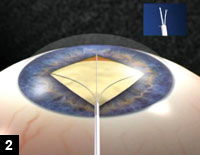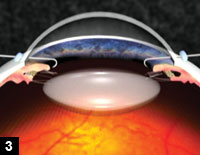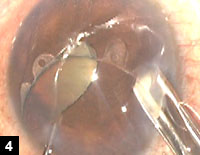Phacoemulsification in small pupils can be difficult in some cases
Surgeons should be familiar with pharmacological and surgical methods to enlarge a miotic pupil.

A well-dilated pupil is the gateway to a smooth, easy and rewarding cataract surgery. But the surgeon may not be lucky enough to sail smoothly through the well-charted path of a dilated pupil each time. Sometimes the door looks narrow and uninviting even for the best surgeon. A miotic pupil (Figure 1) is a common problem that every surgeon faces at some time.
Miotic pupil
 Amar Agarwal |
A small pupil affects all steps of phacoemulsification, from capsulorrhexis to IOL insertion. Difficult maneuvering can cause iris damage, sphincter tears, zonular dialysis, bleeding and other complications. Poor exposure through a small pupil forces the surgeon to make a smaller rhexis, adding further to the difficulty and frequently leading to capsular dehiscence and nucleus drop — the worst nightmare. The prolonged surgical time takes its toll thereafter. Corneal edema, uveitis, secondary glaucoma, cystoid macular edema, distorted pupil — all of these lead to a poor visual outcome, an unhappy patient and a frustrated surgeon.
Preoperative measures
A good surgeon should be prepared to deal with problems on the operating table. A preoperative evaluation should include pupillary dynamics. Poor pupillary dilatation should be detected and noted. Appropriate history is important for detecting any underlying etiology of the miotic pupil, may it be the use of miotics or long-standing diabetes. Any co-existing conditions, such as zonular weakness in pseudoexfoliation or synechiae in chronic uveitis, should be detected preoperatively. The pupil should be dilated with a combination of cycloplegic, mydriatic and NSAID drops.
Sphincter-sparing techniques
Pharmacological mydriasis alone may not be effective in cases with posterior synechiae, pupillary membrane or scarred pupils. Such pupils need intraoperative procedures. High molecular weight cohesive viscoelastics such as Healon 5 or Healon GV (Advanced Medical Optics) can be injected into the center of the pupil to mechanically dissect any synechiae and to stretch the sphincter. If this does not work, synechiolysis may be done with a blunt spatula passed through the side-port incision. Viscomydriasis can then be repeated. Pupillary membranes can be stripped mechanically by Utrata forceps. Pure, preservative-free adrenaline can be added to the irrigation bottle after appropriate dilatation. Care should be taken in hypertensives, and the irrigating solution should be immediately changed to an adrenaline-free solution in case of a posterior capsular rupture.
|
|
|
|
|
Images: Agarwal A |
Sphincter-involving techniques
Mini sphincterotomies, less than 1 mm and limited to the sphincter tissue, can be made with either Vannas scissors or vitreoretinal scissors. This gives adequate dilatation intraoperatively and maintains a functionally and aesthetically normal pupil postoperatively.
Dilatation can also be achieved by pupillary stretching using push-pull instruments. Under viscoelastic cover, two hooks are used in a slow, simultaneous, controlled fashion to stretch the pupil in one or more axes. Two-pronged, three-pronged and four-pronged pupil stretchers are also effective (Figure 2). The prongs should be maintained parallel to the iris plane and should not slip out into the pupil margin, especially when starting to depress the plunger to create the pupil stretch. The disadvantage of pupil stretch techniques is that the iris sometimes becomes flaccid and prolapses through the incision during surgery. Postoperatively, the pupil usually remains aesthetically acceptable.
Commercially available iris hooks can be used to stretch small pupils (Figure 3). Gradual and optimal enlargement of the pupil to a size just adequate for the surgery should be attempted to avoid pupillary atony. The hooks should be placed parallel to the iris plane through small, short peripheral paracenteses. If not placed properly, they can pull the iris diaphragm forward, resulting in chafing and thermal damage during phacoemulsification of the nucleus.
Pupil ring expanders have been introduced to stretch the pupil without sphincter damage. They are inserted through the main port and manipulated into the pupil space. They can create the largest diameter pupil by producing a uniform expanding force of about 300· of the pupil. As they do not produce point pressure on the pupillary margin, sphincter tears are infrequent. One of them is the Perfect Pupil by Milvella (Figure 4), developed by John Milverton, MD, of Sydney, Australia. It is a sterile, disposable, flexible polyurethane ring with an integrated arm that allows easy insertion and removal. It is inserted with forceps or injected with an injector through the main port. The integrated arm remains outside the eye to aid in easy removal. It can be inserted through an incision of less than 100 µm. Because of the open ring design of the Perfect Pupil, there is no interference with other instrumentation.
Intraoperative floppy iris syndrome
Intraoperative floppy iris syndrome has recently been described by David F. Chang, MD, in patients who have been on the alpha-1 receptor antagonist tamsulosin for benign prostatic hypertrophy. These patients have intraoperative iris billowing, iris prolapse and progressive intraoperative miosis. Pupil stretching and sphincterotomies are ineffective in these patients, and they require iris hooks or pupil ring expanders such as the Perfect Pupil.
For More Information:
- Amar Agarwal, MS, FRCS, FRCOphth is director of Dr. Agarwal’s Group of Eye Hospitals. Dr. Agarwal is author of several books published by SLACK, Incorporated, publisher of Ocular Surgery News, including Phaco Nightmares: Conquering Cataract Catastrophes, Bimanual Phaco: Mastering the Phakonit/MICS Technique, Dry Eye: A Practical Guide to Ocular Surface Disorders and Stem Cell Surgery, and Presbyopia: A Surgical Textbook. He can be reached at 19 Cathedral Road, Chennai 600 086, India; fax: 91-44-28115871; e-mail: dragarwal@vsnl.com; Web site: www.dragarwal.com.
References:
- Agarwal A, Agarwal A, Agarwal S. Phacoemulsification. 3rd ed. Thorofare, NJ: SLACK Incorporated; 2004.
- Agarwal A. Phaco Nightmares: Conquering cataract catastrophes. Thorofare, NJ: SLACK Incorporated; 2006.
- Agarwal A. Handbook of Ophthalmology. Thorofare, NJ: SLACK Incorporated; 2005.




